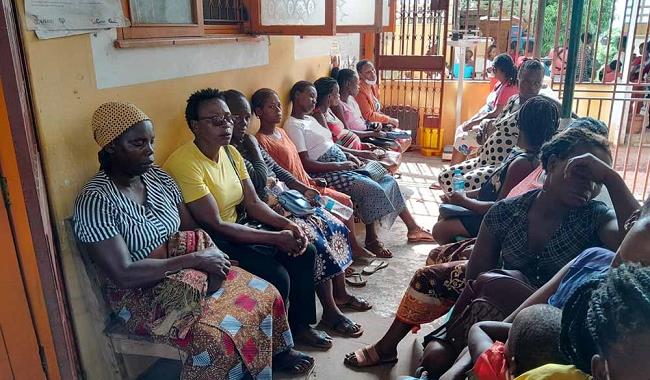A cholera outbreak in the central and northern parts of Mozambique has infected more than 1,300 people, killing 16 others in February alone, while heavy rains continue to pound southern parts of the country.

Health authorities warn that action is needed to contain the epidemic: more than 700,000 doses of oral cholera vaccine are on their way to the highest-risk zones, they say.
“Cholera is showing signs of spreading. It is already in six districts of Mecanhelas, Milange, Caia, Xai-Xai, Lago, and Lichinga. We need to be careful,” Mozambican President Filipe Nyusi told the nation on Thursday, February 16, 2023, during a televised state of the nation address, after the country was hit by severe flooding.
“The next few days could still be dramatic in the country, since the weather forecasts indicate that there will be more rain, which could result in more floods,” warned Nyusi, who asked for local authorities to remain vigilant, and prevent displaced people from returning to the areas of risk.
According to Nyusi, at least 32 people have died of cholera, a waterborne bacterial infection that causes severe acute diarrhoea, since the beginning of the rainy season in October.
“The challenge now is to work to ensure that, at the level of accommodation centres, there are no outbreaks of contamination,” stressed Nyusi.
According to the World Health Organisation (WHO), the cholera outbreak has been growing exponentially since December 2022 with geographic spread to new districts, with heavy rainfall in the first weeks of February threatening to further worsen the situation.
The first case of cholera in the current outbreak was reported to the Ministry of Health and WHO from Lago district in Niassa province on September 14, 2022. As of February 19, 2023, a cumulative total of 5,237 suspected cases and 37 deaths (Case Fatality Ratio (CFR) 0.7%) have been reported in 29 districts from six out of 11 provinces in the country. Of the at least 182 cases tested, 99 cases (54%) were laboratory confirmed for cholera by culture.
All six provinces currently affected by cholera are flood-prone areas. As the rainy season continues, it is anticipated that more districts will be affected. With this outbreak, cholera has affected many districts that had not reported any cases in over five years and where, as a result, the response capacity is limited.
In addition, there is inadequate access to sources of safe drinking water for the population that is already challenged with poor hygiene and sanitation.
Mozambique is one of many countries in the region facing a cholera outbreak at the moment. Notably, neighbouring Malawi is facing the deadliest cholera outbreak in its history. Considering the frequency of cross-border movement and the history of cross-border spread of cholera during this outbreak, WHO considers the risk of further disease spread as very high at the national and regional levels.
Description of the outbreak
The first case of cholera in the current outbreak was reported to the Ministry of Health and WHO from Lago district in Niassa province on September 14, 2022.
As of February 19, 2023, a cumulative total of 5237 suspected cases and 37 deaths (CFR 0.7%) have been reported in 29 districts from six of 11 provinces in the country. Of at least 182 cases tested, 99 cases (54%) were laboratory confirmed for cholera due to the identification of Vibrio cholerae Ogawa by culture. As of February 19, eight districts (Chimbonila, Lago, Lichinga, Mandimba, Mecanhelas, Muembe, Ngauma and Sanga) of Niassa province (north of the country) reported 2525 cases and 16 deaths (CFR 0.6 %).
In the central region of the country, nine districts (Beira, Buzi, Caia, Cheringoma, Chibabava, Gorongoza, Maringue, Marromeu, Muanza) of Sofala province reported 1354 cases and three deaths (CFR 0.2 %). Nine districts (Angonia, Cahora Bassa, Chiuta, Doa, Marara, Moatize, Mutarara, Tete, Tsangano) from Tete province, reported 1271 cases with 12 deaths (CFR 0.9%) since December 2022. Zambezia province (Milange district) bordering Malawi reported 14 cases. In the southern region of the country, one district (Xai-Xai) in Gaza province, reported 42 cases and four deaths (CFR 9.5%). In addition, one district (Tambara) in Manica province, reported 34 cases and two deaths (CFR 5.9%).
Additionally, four districts from three provinces (Tete – two, Zambezia – one, and Cabo-Delgado – one) have reported cases of Acute Watery Diarrhoea (AWD) that were positive for cholera by Rapid Diagnostic Test (RDT) with culture results pending. Notably, in the last 30 days the districts reporting cholera and AWD are increasing, with three new provinces reporting confirmed cholera.
Prior to the current outbreak, there were cholera outbreaks in eight districts in three provinces during the first half of 2022, which were declared over. The current outbreak of cholera in Mozambique covers a wider geographic area and has a higher CFR compared with the previous outbreak.
Moreover, most of the affected districts, especially in Niassa province, had not reported cholera cases for more than five years and many of the health professionals do not have experience in responding to a cholera outbreak. Weak surveillance with late reporting, inadequate WASH conditions (lack of access to safe drinking water, poor sanitation and hygiene practices), a weak health system and exhausted workforce responding to multiple emergencies pose a threat to continued disease progression, as do the ongoing heavy rains of the season.
